The Smith Machine bench press is a variation of the traditional bench press exercise that requires a Smith machine. This setup provides an added level of stability compared to traditional free-weight bench presses.
It is popular among bodybuilders and powerlifters because it helps them lift heavier weights, especially when you’re lifting without a gym buddy or spotter. It also provides a great safety option (safety latch).
The Smith machine bench press primarily works the chest muscles, and it also trains the anterior deltoids and the tricep.
There are many variations of bench press that you can do with the Smith machine, and each one targets different regions of the chest (upper, lower, and inner)
- Smith Incline Bench Press: Set the bench at a 30-45 degree incline to target the upper chest more effectively.
- Decline Smith Bench Press: Targets lower chest by declining bench to 15–30 degrees.
- Close-grip bench Press: Place your hands closer together on the bar. This will emphasize the inner and triceps muscles.
- Wide Grip Bench Press: Grip the bar wider than shoulder-width apart. This exercise targets the outer chest and shoulders.
- Reverse Grip Smith Machine Bench Press: Underhand (supinated) grip on the bar. It places more emphasis on the tricep and upper chest muscles.
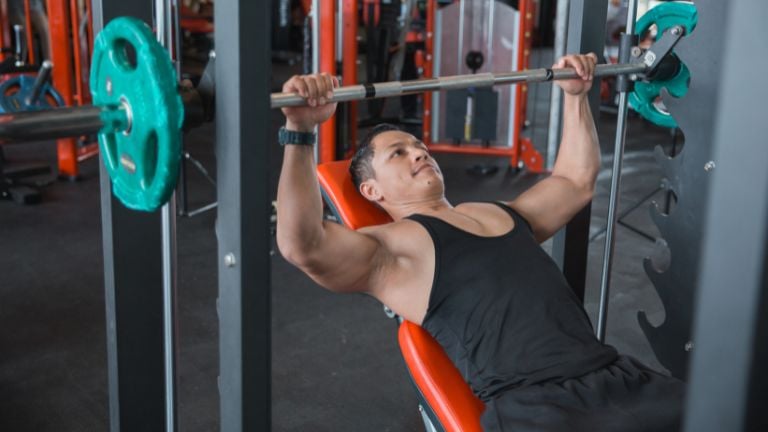
- Smith Machine Bench Press Muscles Worked
- How To Do Smith Machine Bench Press
- Proper Form and Techniques
- 5 Smith Machine Bench Press Variations
- 1. Smith Machine Incline Press
- 2. Smith Machine Decline Bench Press
- 3. Smith Machine Hex Press
- 4. Close-grip Smith Machine Bench Press
- 5. Reverse Grip Smith Machine Bench Press
- Benefits Of Smith Machine Bench Press?
- Risks of the Smith Machine Bench Press?
- References
Smith Machine Bench Press Muscles Worked
The Smith Machine Bench Press is a compound exercise that simultaneously works for multiple muscle groups.
- Primary Muscles Worked: Pectoralis Major —the clavicular head (upper chest) and the sternal head (lower chest)
- Secondary Muscles Worked: Triceps Brachii, Anterior Deltoid and Serratus Anterior
- Stabilizing Muscles: Latissimus Dorsi, Rhomboids and Scapular Stabilizers, Trapezius (Upper, Middle, and Lower), Core Muscles
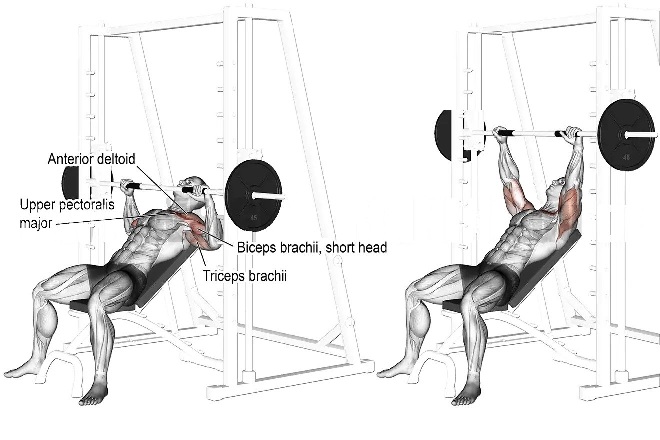
How To Do Smith Machine Bench Press
- Position a flat bench under the Smith machine bar so that when you lie on it, the bar lines up with your lower chest area.
- Set the bar at a height where you can easily reach it while lying down.
- Add the appropriate weight plates to the Smith machine bar.
- Lie flat on the flat bench with your feet firmly planted on the ground. Your head, shoulders, and buttocks should contact the bench throughout the exercise.
- Grip the bar slightly wider than shoulder-width apart. Your palms should be facing away from you.
- Lift the bar slightly to disengage the safety locks and rotate it to free it from its resting position.
- You should start with your arms fully extended and the bar above your lower chest. Keep your eyes focused on a point directly above you.
- Inhale as you slowly lower the bar to your chest. Keep your arms at a 45-degree angle.
- Exhale as you press the bar back to the starting position.
- After completing your set, carefully rotate the bar back into the locked position.
Proper Form and Techniques
- Set up the bench directly underneath the barbell to vertically verticalize the bar path.
- Plant your feet firmly on the ground about hip-width apart to create a stable base. Engage your core.
- Use a shoulder-width grip or slightly wider. Do not grip the bar too narrowly.
- Unrack the bar with control, keeping your elbows tucked in close to your sides. Avoid flaring your elbows out.
- Keep your head, shoulders, and buttocks in contact with the bench.
- Inhale as you slowly lower the bar to the middle of your chest in a controlled manner. Do not bounce or slam the bar down.
- Make sure to touch your chest, then pause briefly before pressing the bar back up.
- Your elbows should be slightly tucked in, not flared out, to better engage the chest, shoulder and triceps.
- Use a full range of motion on every rep. Control the bar both downward and upward.
- If using heavy weights, do not arch your back excessively or lift your hips off the bench.
- After completing your set, carefully rotate the bar back into the safety hooks.
5 Smith Machine Bench Press Variations
The Smith machine bench press can be done differently to suit your fitness level.
If you are new to performing the Smith machine bench press, you may want to apply a few modifications to make it easier. One way to counter this problem is to start with a flat bench. Another is to use a lighter weight.
If you want a more advanced variation to stimulate different muscle fibers in the chest and triceps, try the close grip and decline the Smith bench press. Using heavier weights, reps, and sets can make it more difficult.
1. Smith Machine Incline Press
An incline Smith machine bench press will work the upper part of your chest more than a flat or decline bench press. If you want to increase the stimulation of the upper chest, you should aim for an angle of at least 30 degrees.
The study found that the most activity for the upper part of the pectoralis major muscle occurred when the bench was angled at 30 degrees.
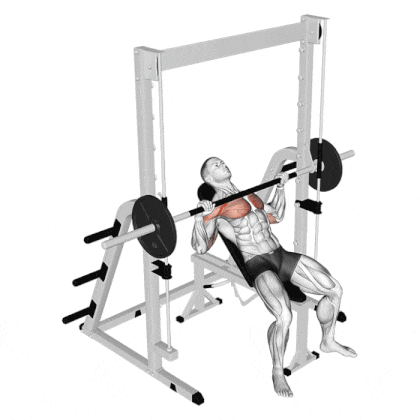
How To Do
- Adjust the bench to an inclined position (30-45).
- Position yourself on the bench with your feet flat on the floor for stability.
- Keep your shoulders retracted and your back firmly pressed against the bench.
- Grasp the barbell with an overhand grip slightly wider than shoulder-width apart.
- Unrack the barbell by lifting it off the safety catches and hold it directly above your chest.
- Lower the barbell slowly and under control until it touches your upper chest.
- Push the barbell back up along the same path until your arms are fully extended, but avoid locking out your elbows.
2. Smith Machine Decline Bench Press
The lower chest is one of the harder areas to train because of the lack of variations available and the limited motion range. That is why it is so important to include these best lower chest exercises into your routine.
If you’re looking for one more effective lower chest exercise, try the smith machine decline bench press. It eliminates some of the need for shoulder stability during the exercise, allowing the lifter to better isolate the lower chest muscles.
Research indicates that the correct angle for the decline bench press should be 15–30 degrees declined from flat to target the lower chest.
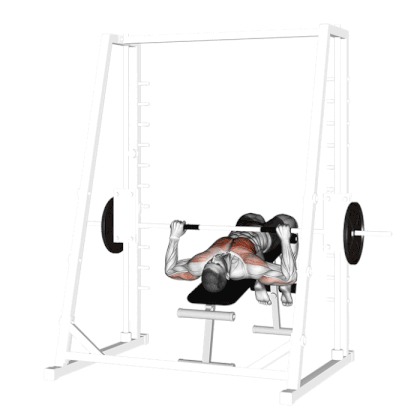
How To Do
- Lie flat on a decline bench inside the smith machine and set your hands just outside of shoulder width.
- Lower the bar straight to the base of the sternum (breastbone) and touch the chest.
- Push the bar back up in a straight line by pressing yourself into the bench.
- Hold this position for a count and repeat for the desired number of repetitions.
3. Smith Machine Hex Press
The Smith machine hex press allows for a greater range of motion and more emphasis on the inner chest muscles than a traditional bench press. It provides effective engagement and excellent weight distribution.
However, it is challenging to organize and requires much attention and detail to perform this workout.
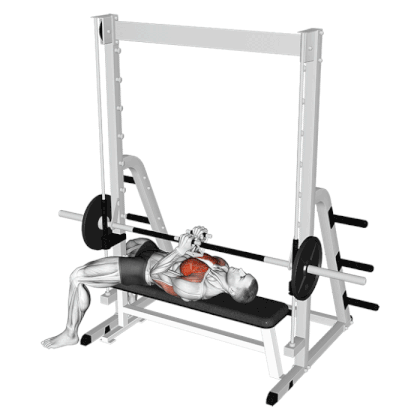
How To Do
- Set up a Smith machine with the bar at waist height.
- Lie on a bench with your feet flat, and position yourself underneath the bar.
- Grip the bar with the V-Bar handle and slowly lift it off the rack.
- Press them straight out in front of your chest.
- Lower the weights under control. Then, repeat the desired number of reps.
- Focus on mind-muscle connection
4. Close-grip Smith Machine Bench Press
The Smith Machine Close Grip Bench Press is a great exercise for your triceps, but many people don’t do it well. This compound exercise is ideal for both novice and experienced exercisers, as it allows you to focus on the triceps.
Since this is a bench press variation, you may feel good pec engagement. You may also feel some anterior deltoid engagement.
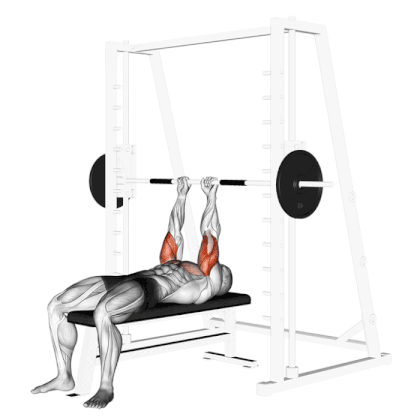
How to Do
- Place a flat bench underneath the Smith Machine.
- Lie down on the flat bench with your back flat and your feet firmly planted on the floor for support.
- Using a close and pronated grip (palms facing forward) that is around shoulder width, unlock the bar from the rack and hold it straight over you with your arms locked.
- Inhale and lower the bar in a controlled manner to your mid-chest.
- Exhale as you push the bar back to the starting position, focusing on squeezing your triceps and inner chest.
5. Reverse Grip Smith Machine Bench Press
The Reverse Grip bench press is a less-common but highly effective variation of the standard Smith Machine Bench Press.
In this exercise, instead of holding the barbell with your palms facing away from you, you should grip it so that your palms are facing toward you.
This grip variation places a greater emphasis on the upper pectoral muscles, which are often harder to target. It also targets the upper chest, front delts, and triceps muscles.
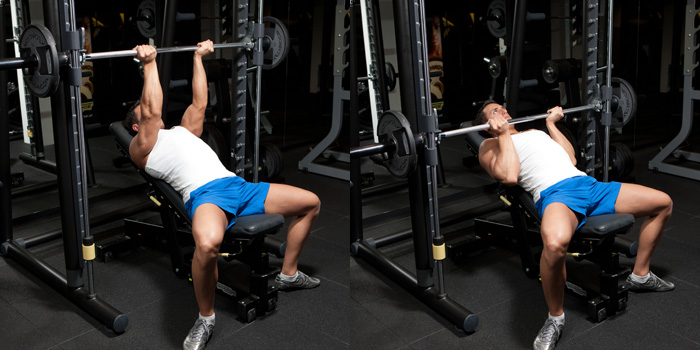
How To Do
- Lie down flat on the bench, feet firmly on the ground. Keep your shoulder blades pulled together and down.
- Grip the bar with a reverse grip, palms facing towards you, and hands spaced at about shoulder-width apart.
- Lift the bar slightly to disengage the safety and rotate it to free it from the resting hooks.
- Inhale and lower the bar towards your upper chest in a controlled motion.
- Exhale and push the bar back to the starting position, concentrating on your upper chest and triceps.
Benefits Of Smith Machine Bench Press?
- The Smith machine guides the barbell on a fixed vertical track, which offers better stability and control than free weights.
- The controlled motion allows for better isolation of target muscles like the chest, shoulders, and triceps.
- They come with built-in safety mechanisms, like adjustable safety stops and hooks, that can catch the bar if you lose control. This feature can be beneficial for lifting heavy weights without a spotter.
- The guided motion of the Smith machine makes it easier for beginners to learn the mechanics of the bench press without the instability that comes with free weights.
- The Smith machine can be used for various bench press variations, including close-grip, reverse-grip, and incline bench presses, giving you more ways to target different muscle groups.
- Because the barbell’s motion is controlled, there is often less risk of arching the back excessively.
- With a Smith machine, you can perform burnout sets or drop sets more quickly and safely, allowing for a more focused and time-efficient workout.
Risks of the Smith Machine Bench Press?
The Smith Machine Bench Press has many benefits, but it’s also important to know about the risks and disadvantages.
If you use the Smith machine for bench pressing incorrectly or do not understand the exercise mechanics, you can have problems.
- The barbell’s guided path on the Smith machine doesn’t require the same activation of stabilizing muscles as a free-weight bench press, which can lead to a less comprehensive training effect.
- The Smith machine can give some users a false sense of security, leading them to neglect proper form. Incorrect body alignment can still occur, potentially causing strains or other injuries.
- A barbell naturally moves in a slightly curved path during a free-weight bench press, but the Smith machine forces a strict vertical path. This unnatural movement could stress your shoulder, wrist, and elbow joints.
- Although Smith machines have safety stops, they aren’t foolproof. Setting them incorrectly or neglecting to set them at all could result in a failed lift and potential injury.
- Some users may not be familiar with how to properly set up and use a Smith machine, leading to an increased risk of injury.
References
- Cacchio, Angelo & Don, Romildo & Ranavolo, Alberto & Guerra, Enrico & Mccaw, Steven & Procaccianti, Rita & Camerota, Filippo & Frascarelli, Massimo & Santilli, Valter. (2008). Effects of 8-week strength training with two models of chest press machines on muscular activity pattern and strength. Journal of electromyography and kinesiology : official journal of the International Society of Electrophysiological Kinesiology. 18. 618-27. 10.1016/j.jelekin.2006.12.007.
- McCaw, Steve & Friday, Jeffrey. (1994). A Comparison of Muscle Activity Between a Free Weight and Machine Bench Press. The Journal of Strength and Conditioning Research. 8. 259. 10.1519/1533-4287(1994)008<0259:ACOMAB>2.3.CO;2.

Manish is a NASM-certified fitness and nutrition coach with over 10 years of experience in weight lifting and fat loss fitness coaching. He specializes in gym-based training and has a lot of knowledge about exercise, lifting technique, biomechanics, and more.
Through “Fit Life Regime,” he generously shares the insights he’s gained over a decade in the field. His goal is to equip others with the knowledge to start their own fitness journey.
